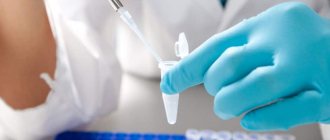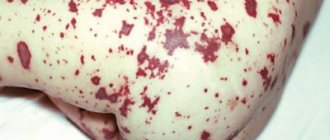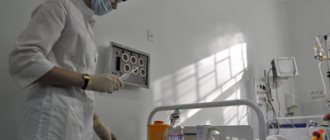Recently, there have been frequent references in the press to outbreaks of meningitis that claim the lives of children and adults. Is there really a threat of an epidemic? And how to protect yourself and your children from this disease? Our expert is a pediatrician, infectious disease specialist at the Federal State Budgetary Educational Institution of Higher Education Russian National Research Medical University named after N. I. Pirogov of the Ministry of Health of the Russian Federation, Morozov Children's City Clinical Hospital, Chief Specialist in Infectious Diseases in Children in the Central Administrative District of Moscow, Candidate of Medical Sciences Alexey Rtishchev .
Meningitis (inflammation of the membranes of the brain) is an extremely dangerous disease. According to WHO estimates, up to 50% of patients die without treatment, and serious complications occur in more than 10% of cases. Alas, even timely medical care does not always guarantee a successful outcome. In 70% of cases, children suffer from this disease (the smaller the child, the more severe the meningitis and the worse the prognosis).
Virus, fungus or bacteria?
There are many pathogens for meningitis. For example, it can be caused by viruses. In summer, meningitis occurs more often, caused by an enterovirus, which enters the body from dirty hands or through water. Secondary meningitis caused by influenza or mumps viruses may also occur. Less commonly, the disease is caused by a fungal infection. It is impossible to distinguish the causative agent of the disease by eye - this requires laboratory analysis of the cerebrospinal fluid.
Viral meningitis is often not as dangerous as bacterial meningitis. The latter are caused by meningococci, as well as pneumococci and Haemophilus influenzae type B.
Click to enlarge
Bacterial meningitis: causes of the disease, main symptoms, prevention
Bacterial meningitis (meningoencephalitis) is an inflammation of the membranes (substance) of the brain or spinal cord, which can be caused by various pathogens. The leading role in the occurrence of these diseases is given to three pathogens - meningococci, pneumococci and Haemophilus influenzae. To a lesser extent, listeria, staphylococci, enterococci and a number of other microorganisms are relevant. Bacterial meningitis of meningococcal, pneumococcal and hemophilic etiology is registered in the Republic of Belarus. Up to 50% of the number of cases occurs in children, of whom children under 2 years of age most often get sick.
Despite the relatively low incidence of purulent bacterial meningitis, they represent an urgent problem, which is associated with high mortality (especially in young children), reaching 30-60%, and a high incidence of organic damage to the central nervous system with subsequent motor and intellectual impairment.
The most susceptible to meningitis (meningoencephalitis) are children aged 6 weeks to 5 years, persons 16 – 25 years old and persons over 55 years old.
A special risk group includes children under 1 year of life, especially weakened children suffering from malnutrition, rickets, those born after an unsuccessful pregnancy, as well as children with a weakened immune system.
The source of infection is a sick person or a bacteria carrier.
Transmission of infection from a sick person to a healthy person occurs in most cases through airborne droplets (coughing, sneezing, talking). Infection can also occur through the fecal-oral route (the source of infection is dirty hands), contact through household contact (through objects used by the patient). Meningitis can be transmitted after swimming in contaminated waters.
The incubation period is 2-12 days. Then, within 1-3 days, acute nasopharyngitis develops with high body temperature (up to 38°C). The penetration of pathogens into the bloodstream is accompanied by a sudden attack of chills, headache and an increase in body temperature up to 40°C. Meningitis develops acutely, with chills, fever, headache, nausea, and vomiting.
The main signs of meningitis are:
- severe headache (may worsen when exposed to light and sound), lethargy;
- an increase in body temperature to 40°C, which is practically not reduced by conventional antipyretics;
- vomiting that does not bring relief;
- rigidity of the neck muscles (try to press the chin to the chest of the sick person lying on his back - this is very difficult to do, and most often, simply impossible);
- those who are sick try to lie on their side, with their legs tucked in and their head thrown back;
- on the first day of the disease, a rash appears in the form of pink spots ranging in size from 5 to 20 mm on the stomach, legs, buttocks, and heels;
- In babies under one year of age, the fontanel may swell.
No one is immune from meningitis (meningoencephalitis).
To minimize the risk of disease, you need to take care of the following:
- timely treatment of dental diseases, ENT organs (sinusitis, sore throat, bronchitis);
- Observe personal hygiene rules, always wash your hands with soap;
- try to refrain from contact with people with meningitis, as there is a risk of infection, for example, through kissing, coughing, sneezing, as well as through sharing personal hygiene items;
- If you have been in contact with someone who has meningitis, you will be asked to undergo laboratory testing and/or take antibiotics. Don't refuse doctor's appointments!
- Eat only washed vegetables and fruits, drink only bottled water.
- Do not swim in unknown and possibly polluted waters.
It is worth noting the possibility of preventing certain neuroinfectious diseases using specific immunoprophylaxis. Meningitis is a disease caused by various pathogens, and there cannot be a universal remedy that can protect against them.
In accordance with the National Calendar of Preventive Vaccinations in the Republic of Belarus, starting from 2021, scheduled vaccination of all children against hemophilus influenzae infection is being carried out. This makes it possible to protect children from severe manifestations of this disease: meningitis, meningoencephalitis, septicemia caused by this pathogen, a number of non-invasive forms of Haemophilus influenzae infection (otitis, sinusitis, etc.).
As part of the National Calendar, children belonging to risk groups are vaccinated against pneumococcal infection, as well as all children are vaccinated against measles and rubella, which eliminates the development of neurological complications of these diseases.
In the Republic of Belarus, the proportion of people vaccinated against the vast majority of infections, vaccinations against which are provided for in the National Calendar, is consistently high. This allows us to form collective immunity and prevent the spread of infections.
The vaccination calendar is constantly being improved. Currently, issues of expanding the population for vaccination against pneumococcal infection and the issue of vaccination against meningococcal infection are being considered.
REMEMBER! If symptoms of meningitis occur, you should never self-medicate. The disease can develop rapidly and only a doctor can give a correct objective assessment of the patient’s condition, especially a child in the first months of life.
State institution "Grodno Zonal Center for Hygiene and Epidemiology" 2019
A period of imaginary prosperity
The last rise in meningococcal infection was observed in 2003–2004. There were at least twice as many cases of the disease then as there are today. The surge in infection led to the formation of an “immune layer”, thanks to which people began to get sick less often. But last year there was an increase in the incidence of meningitis by more than 13%.
It is quite easy to get this infection. This can happen through the usual airborne route, but only with close contact with the source of infection. Even children who do not attend kindergartens are not insured. The fact is that some people (usually adults) are only carriers of dangerous bacteria, while they themselves either feel normal or experience only symptoms of a mild acute respiratory infection. Therefore, children often become infected at home from their own parents, brothers or sisters. People at particular risk of contracting meningitis include people living in crowded conditions - first-year students living in dormitories, migrant workers, military recruits, as well as people with a removed spleen and various immunodeficiencies.
Article on the topic
Attack of the mutants. What dangerous diseases await Russians this winter?
Who's at risk
The bacteria that cause meningitis are often found in the nasopharynx of healthy people. A person may feel normal, but, without suspecting anything, infect others with weaker immune systems. However, he himself may get meningitis under the influence of some unfavorable factor. Dormant bacteria in the body can be activated by stress, hypothermia, overwork, sudden climate change or some other infection.
Questions and Answers How can you become infected with serous meningitis?
The risk of getting meningitis is especially high among residents of large cities, who, willy-nilly, come into contact with a large number of people. Outbreaks of meningitis often occur among recruits. The stress experienced by conscripts, the drastic change in the lifestyle of young soldiers, and the cramped conditions of the barracks also have an impact. For similar reasons, outbreaks of meningitis are sometimes recorded among first-year students.
Caution, heat!
Meningitis does not have any one significant symptom. And the signs of this disease can easily be confused, for example, with the flu. Therefore, with any rise in temperature above 38–39 degrees and a sharp deterioration in the child’s general condition, it is better to immediately consult a doctor. Doctors have several tests that can help suspect meningitis. For example, a dangerous sign is when a child cannot bring his chin to his chest. In this case, the patient must be urgently hospitalized. Many believe that a purple rash on the skin is the main symptom of meningitis. In fact, bright spots on the body, buttocks and other places are a sign of meningococcemia, which can be combined with meningitis, or can occur separately. This rash itself is a sign that the infectious agent has spread through the bloodstream, that is, sepsis has begun. This is a life-threatening situation. Moreover, sometimes not even a day passes from the appearance of the first symptoms to the death of the patient.
Treatment is always comprehensive
In the treatment of viral meningitis, antiviral drugs are used. Purulent meningitis is treated with antibiotics, like any bacterial infection.
Article on the topic
Dirty hands disease: how to deal with meningitis
To ensure that the brain suffers as little as possible in this critical situation, drugs that support its functions must be prescribed in parallel: improving cerebral circulation and nutrition of brain cells. They continue to drink them even with the most favorable outcome after complete victory over the pathogen. After all, biochemical processes in the brain are restored only 6–18 months after recovery. That is why all patients who have had meningitis are required to be registered with a neurologist for two years, undergo periodic examinations and rehabilitation courses, even if they have no health complaints. Children who have had this infection are limited in physical activity and protected from violent emotions and strong psychological experiences.
A terrible threat
Since meningitis can lead to death in a matter of hours, a small patient requires hospitalization as soon as possible. But, alas, even the necessary treatment started on time does not always save, especially if a child under 1 year of age is ill. Meningococcal infection is dangerous and has complications. It thromboses blood vessels, which can cause areas of tissue necrosis (death) in the limbs. Therefore, among the possible consequences is amputation of limbs. Meningitis can also negatively affect many mental functions (memory, for example), and also lead to paralysis and paresis. The infection is fraught with decreased or loss of hearing and vision, the development of epilepsy, decreased intelligence and delayed mental and motor development in children.
Meningitis: how to recognize and how to avoid getting sick. Infographics Read more
Diagnosis of meningitis in children
Decisive for confirming the diagnosis of meningitis in children is the examination of cerebrospinal fluid. It is obtained by lumbar puncture. According to indications, children undergo additional studies:
- radiography of the skull and paranasal sinuses;
- fundus examination;
- electroencephalography;
- echo-encephalography;
- computer and nuclear magnetic resonance tomography.
During a spinal puncture, the pressure of the cerebrospinal fluid, the visual characteristics of the cerebrospinal fluid (color, transparency) are determined, and the cerebrospinal fluid dynamic tests of Stuckey and Queckenstedt are performed. In the liquid sediment, the number and composition of cells and the presence of microorganisms are determined. Biochemical (glucose, protein, chloride content, sediment samples) and microbiological studies are carried out.
With meningococcal meningitis in children, the cerebrospinal fluid is cloudy, yellowish or milky white. One milliliter of cerebrospinal fluid contains several thousand neutrophils. Characteristic bean-shaped diplococci are often visible in their cytoplasm. When sowing, a culture of the pathogen is isolated. An increased amount of protein and a decreased level of glucose are detected in the cerebrospinal fluid. Using immunological methods, the pathogen's antigen is detected in the cerebrospinal fluid, and its DNA is detected using the polymerase chain reaction. Signs of a pronounced inflammatory process are detected in the blood.
With pneumococcal meningitis in children, meningeal syndrome is detected somewhat later than with meningococcal infection. Even if the child is hospitalized early, the disease progresses rapidly. Disorders of consciousness, convulsions, and often paresis of cranial nerves or partial paralysis of half the body appear early. The cerebrospinal fluid is purulent. In it, under a microscope, extracellularly located lanceolate-shaped diplococci are visible.
Meningitis caused by Haemophilus influenzae is most often observed in children under one year of age. The disease can begin either acutely or gradually. Meningeal symptoms appear on days 2–5 of illness. In children under one year of age, the most serious signs of meningitis are regurgitation or vomiting, bulging and cessation of pulsation of the fontanel, and an unmotivated high-pitched cry.
Viral meningitis is preceded by a clinical picture characteristic of the corresponding infection. Symptoms of meningitis appear later. With viral meningitis, body temperature rises to moderate numbers, meningeal symptoms appear on the 2-3 or 5-7 seventh day from the onset of the disease. Children are bothered by an intense headache, which goes away after a diagnostic lumbar puncture and evacuation of a small amount of cerebrospinal fluid.
Saving injection
There are effective vaccines against meningococcal disease. In Europe, babies are vaccinated against meningitis from the first months of life, in the USA teenagers are vaccinated. Alas, the vaccine against this disease is not yet included in the Russian vaccination calendar, and therefore parents can use it in most cases at their own expense. The vaccine registered in Russia includes the 4 most common pathogens of meningococcal infection - A, C, W and Y. Children are vaccinated with it starting from 9 months. A vaccine against another common meningococcus, group B, is not yet available in Russia. But, since the causative agents of meningitis can be not only meningococci, but also other bacteria, parents should also think about the possibility of vaccinating their children with the vaccine against Haemophilus influenzae (HIB) and the vaccine against pneumococcal infection (the latter was introduced into the National Calendar in 2014). vaccinations).
Article on the topic
Doctors signal SOS. WHO named 12 bacteria resistant to antibiotics
Our information
Meningococcal group A vaccine, dry polysaccharide (Russia), from 700 rub. Allows protection against meningococci serotypes A and C. Allowed for use from 1 year, after 3 years revaccination is required.
Meningo A + C (France), from 1500 rub. Prevents the development of cerebrospinal meningitis. For adults and children over 2 years old.
Mencevax ACWY (Belgium), from RUB 4,000. Protects against serogroups A, C, W, Y. For children from 2 years of age and adults.
Menactra (USA), from RUB 4,000. Protects against the causative agent of meningococcal infection from serogroups A, C, Y and W‑135. Used in children over 9 months. and adults under 55 years of age. At the age of 9 months to 2 years, the vaccine is given twice with an interval of 3 months, and after 2 years - once.
According to the order of the Ministry of Health, free vaccination against meningococcal infection is carried out only for epidemic indications.
Personal application experience
At the Sanare clinic, patients (children) aged 9 months and older were vaccinated with Menactra. The vaccine was well tolerated. There were no complaints in the post-vaccination period. (All patients at the clinic were called and interviewed by a nurse the next day).
The first to be vaccinated with the drug "Menactra", after its arrival at the clinic, were pediatricians, clinic staff, as well as their children (aged from 2 to 11 years). The drug was also well tolerated.










